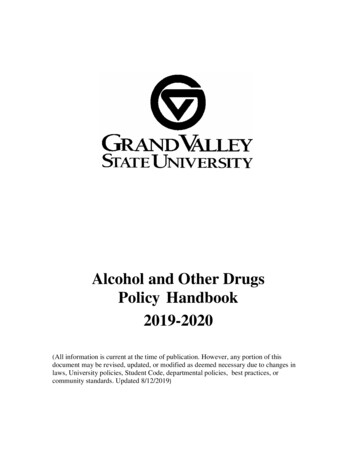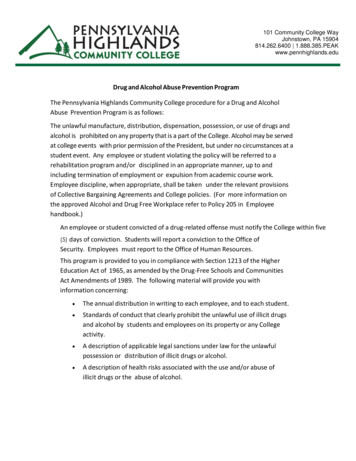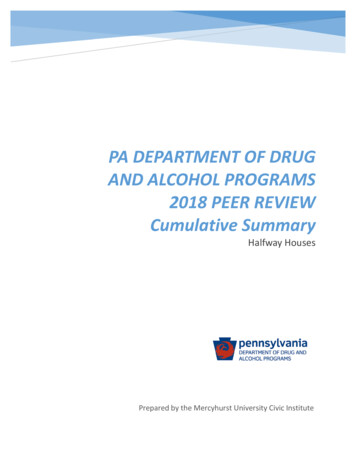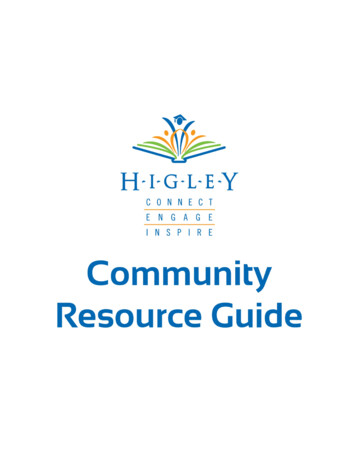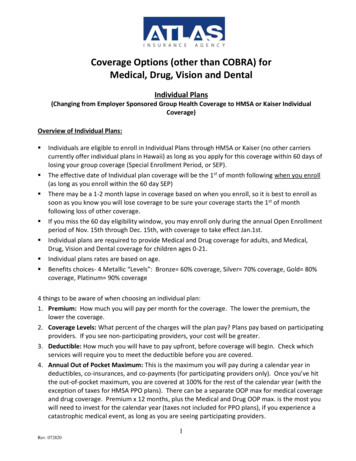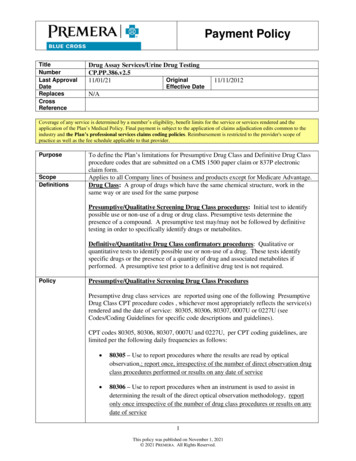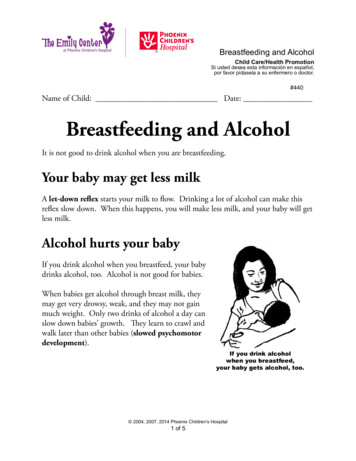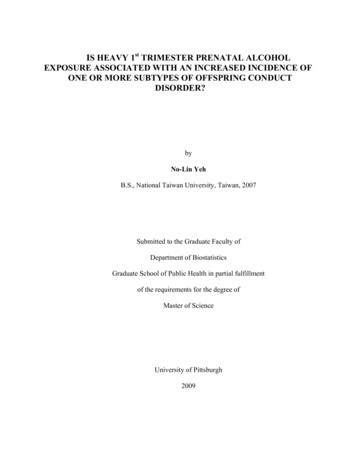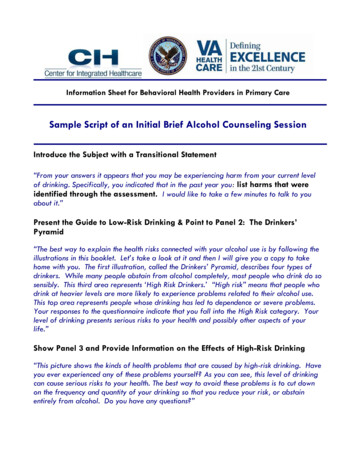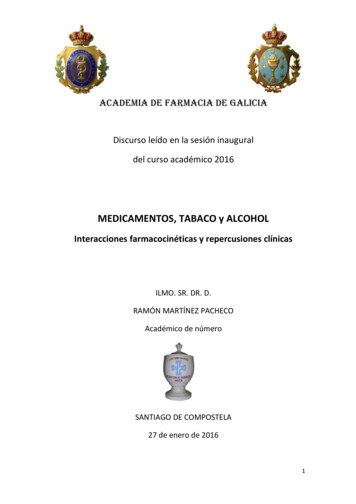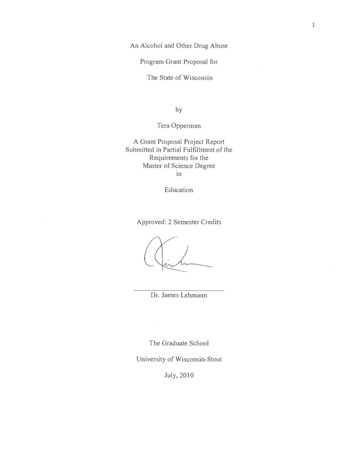
Transcription
1An Alcohol and Other Drug AbuseProgram Grant Proposal forThe State of WisconsinbyTera OppermanA Grant Proposal Project ReportSubmitted in Partial Fulfillment of theRequirements for theMaster of Science DegreeInEducationApproved: 2 Semester CreditsDr. James LehmannThe Graduate SchoolUniversity of Wisconsin-StoutJuly, 2010
2The Graduate SchoolUniversity of Wisconsin-StoutMenomonie, WIAuthor:Opperman, Tera M.Title:An Alcollol and Otller Dl'l1g Abuse Program Grant Proposal for tileState of WisconsinGraduate Degree/ Major: MS Education ·Research Adviser:Dr. James Lehmann, Ph.D.MonthNear:July, 2010Number of Pages:59Style Manual Used: American Psychological Association, 6 th editionAbstractThe purpose of this grant is to reduce the amount of students that repOlt underagedrinking and binge drinking. Statistics prove that western Wisconsin is a problem area when itcomes to alcohol abuse. The YRBS survey reported that Osseo-Fairchild students are well abovethe state and national averages when considering underage drinking and binge drinking. In orderto reduce the amount of underage alcohol use and abuse this program was designed to enhanceand expand the comprehensive school health program of Osseo-Fairchild school district. Theproject focuses on three areas; student education and support, parent awareness and educationprograms, and staff education. Through a combination of evidence based curriculum, structuredAlcohol and Other Drug Abuse (AODA) activities outside of the classroom, opprotunities forparents to get involved and staff professional development an AODA program will be formed ineffOlts of reducing underage drinking and increasing education, not only to the students, but to
3their parents as well, of the dangers of underage drinking. There will be continuous added inputfrom teachers, parents, and law enforcement to develop the curriculum and activities needed toform an effective fit for our community and make the program a success.
4The Graduate SchoolUniversity of Wisconsin StoutMenomonie, WIAcknowledgmentsI would like to thank my family and friends for being so patient with me during theprocess of writing this grant proposal. I would like to acknowledge my research advisor Dr.James Lehmann for helping me out with every aspect of this paper even when he was inEcuador. The time he spent helping me through this entire process is greatly appreciated .
5Table of Contents. PageAbstract . 2Chapter I: Introduction . 7Statement of the Problem . 8Purpose of the Study . 9Definition of Terms . 9Methodology . 10Chapter II: Literature Review . 12Introduction . 12Consequences of Acute Impairment . 12Long-Term Consequences of Underage Alcohol Use . 18Summary . 20Chapter III: Project Goals and Objectives . 21Chapter IV: Project Methodology . 24Action Plan and Timeline . 24Evaluation Plan and Tools . 35Dissemination Plan . 3 7Budget . 37References . 40Appendix A: Cover Letter . 44Appendix B: Grant Foundation Proposal Request . .45Appendix C: Action Plan Timeline Summer Months . 46
6Appendix D: Action Plan Timeline First Semester . . . . 47Appendix E: Action Plan Timeline Second Semester . . .49Appendix F: District Hired Personnel Budget . 51Appendix G: Purchased Services Budget . 52Appendix H: Non-Capital Object Budget . . 54Appendix I: Student Programs Assessment Page from AODA Assessment Tool . 55
7Chapter I: IntroductionThe Osseo-Fairchild School District is located in rural Osseo, WI. The district is home totwo elementary schools one is located in Osseo and one in Fairchild, WI. In 6 th grade studentsenter the middle school which is a joined building with the high school in the city of Osseo, WI.The district covers several counties including Clark, Trempealeau, Eau Claire and Jacksoncounties. The Osseo-Fairchild School District educates just over 1,000 students in thesebuildings. The Osseo-Fairchild School District serves students who live in several countiesincluding Clark, Trempealeau, Eau Claire and Jackson counties making the district at a distinctdisadvantage for funding of substance abuse programs.An example of this inadvertent geographical discrimination is the DARE program. In theyears before 2008 , the DARE program was made available to 5th grade students at both OsseoElementary and Fairchild Elementary through funding from Trempealeau County. Whenfunding from the state for these types of programs was reduced, there was not enough money toprovide for all of the existing DARE programs that the county funded. In order to save some ofthe existing DARE programs, Trempealeau County cut funding of the DARE program to theOsseo-Fairchild School District because the program would then service students from thesurrounding counties as well.Another example of the disadvantages that Osseo-Fairchild faces in terms of funding iseven though Osseo-Fairchild serves students in Eau Claire County, the schools themselves arenot located in Eau Claire County. This is a disadvantage because Eau Claire School District is alarge district and has its own Alcohol and Other Drug Abuse (AODA) coordinator that is trainedin grant writing. Smaller Eau Claire area schools like Augusta and Fall Creek that is located are
8Eau Claire County are able to utilize the AODA coordinator's grant writing services and oftenfunding from the grants that Eau Claire AODA Coordinator writes.Unfoltunately, regardless of the lack of funding, students in the Osseo-Fairchild SchoolDistrict need these programs. The district has struggled with issues related to underage alcoholabuse. The Youth Risk Behavior Survey (YRBS) is a national survey that the Osseo-FairchildSchool District participates in bi-annually. The results of the YRBS administered in 2009showed that percentages of answers to questions addressing underage alcohol use were at least5% above the state average in the categories of binge drinking, drinking and driving or riding ina car with someone who had been drinking, and attending parties where alcohol is present.The results from the survey reflect a serious problem in regards to underage drinking andreveal a need for programs to reduce and prevent the prevalence of underage drinking in theOsseo-Fairchild School District. This chapter will address the need for Alcohol and Other DrugAbuse (AODA) programs, express a purpose of the proposed AODA grant programs, definitionsof common AODA terms, and a methodology of the grant proposal.Statement of the ProblemAlcohol use constitutes one of the most serious public health issues for young people inthe United States. (SAMHSA, 2010). In fact, according to the National Youth Risk BehaviorSurvey (YRBS) released in early June, alcohol remains the substance with the highest rate of useamong high school students at 72.5%. Tragic health, social, and economic problems result fromthe use of alcohol by youth. Underage drinking is a causal factor in a host of serious problems,including homicide, suicide, traumatic injury, drowning, burns, violent and propelty crime, highrisk sex, fetal alcohol syndrome, alcohol poisoning, and need for treatment for alcohol abuse anddependence. Approximately 5,000 young people under the age of 21 die as a result of underage
9drinking each year. Wisconsin ranks 26th highest among the 50 states for the cost per youth ofunderage drinking. Underage drinking cost the citizens of Wisconsin 1.3 billion in 2007(National Institute on Alcohol Abuse and Alcoholism, 2010). Schools constitute the primarypublic institutions with access to youth under 20 years of age. Thus, the most commonprevention strategy for youth is education--especially school-based prevention. Research hasdemonstrated the effectiveness of specific school-based strategies, and the benefits of schoolbased drug prevention are thought to exceed the costs (Bell, 2005). It is imperative that schoolsare on the front line fighting to educate students of the dangers of underage alcohol use andimplement programs to prevent underage drinking.Purpose of the Grant ProposalThe goal of this grant proposal is to fund and sustain programs that will aid in loweringthe amount of students in the Osseo-Fairchild School district that rep0l1 engaging in riskybehaviors regarding underage alcohol use. The programs will be aimed at not only reducing theamount of students who report underage drinking but will also focus on preventing activities thatinclude underage drinking. Funding for the program will include Osseo-Fairchild SchoolDistrict employees, students and parents.Definition of TermsAODA. The acronym AODA, as used in this grant proposal, stands for alcohol and otherdrug abuse. The acronym has commonly been combined as A TODA in the state of Wisconsin toincorporate alcohol, tobacco and other drug abuse.YRBS. The acronym YRBS, as used in this grant proposal, stands for Youth RiskBehavior Survey. The Wisconsin YRBS is conducted as pat1 of a national effort by the U.S.Centers for Disease Control and Prevention to monitor health-risk behaviors of the nation's high
10school students. These behaviors, in turn, result in the most significant causes of both mortalityand morbidity during youth and adulthood. The behaviors monitored by the Wisconsin YRBSinclude traffic safety; weapons and violence; suicide; tobacco use; alcohol and other drug use;sexual behavior; and diet, nutrition and exercise.STARS. The acronym STARS stands for start taking alcohol risks seriously. StartTaking Alcohol Risks Seriously for Families is a health promotion program for preventingalcohol use among at-risk middle and junior high school youth (11 to 14 years old). The goal ofSTARS for Families is to have all youth postpone alcohol use until adulthood. STARS forFamilies matches media-related, interpersonal, and environmental prevention strategies to eachchild's specific stages of alcohol initiation, stages of readiness for change, and specific risk andprotective factors. This innovative program has been shown to result in avoidance of, orreductions in, alcohol use among pmiicipating youth (SAMHSA, 2010).MethodologyThe AODA program grant will fund programs that aim at reducing and preventingunderage alcohol use through the adoption of evidence based programs including STARS,DARE, Love and Logic and other successful AODA interventions. Many of the activities thatthis program will encompass also will have positive side effects on the other issues revealed inthe YRBS and the Search Institute Survey including raising self esteem, a more apparent caringschool environment, increased academic performance and improved relationships withclassmates, school staff and the community. The program will focus on reducing alcohol use byimplementing programs for students, staff and parents in the Osseo-Fairchild School District.The following chapters will discuss the importance of AODA programs and how through grant
11funding Osseo-Fairchild School District aims to achieve the goal of reducing and preventingunderage alcohol use in the district.
12Chapter II: Literature ReviewIntroductionThis chapter addresses consequences of acute impairment and the long termconsequences of underage drinking. The chapter covers a literature review of adolescent healthrisks of acute impairment including alcohol poisoning, sexual activity, drinking and dri ving, andviolence including; homicide, suicide, and unintentional injuries. The chapter also reviews anumber of the long term consequences of underage drinking including effects of braindevelopment and alcohol use disorders.Alcohol use among school aged students is becoming a national health concern.According to the 2007 National Youth Risk Behavior Survey, 44.7% of student's surveyedgrades 6 th through 11 th had had at least one drink of alcohol on at least one day during the thiliydays before the survey, and 7S% of the students had had at least one drink at least one day duringtheir life. Almost a quarter of those students reported having their first drink before the age ofthirteen (Eaton et al. 2008). "Many adults may assume that the risks and potential consequencesof underage drinking are more or less the same as they are for adults, but research suggests thatthe dangers of youth drinking are magnified" (Bonnie & O'Connell, 2004). Alcohol is now themost commonly used drug among youths and is linked to many different health outcomes(Swahn, Bossarte, & Sullivant, 2008). In addition to personal negative health outcomes, theannual social cost of underage drinking is S3 billion (Mosher, Hingson, Bunker, &Bonnie,200S).Consequences of Acute ImpairmentBinge Drinking and Alcohol Poisoning. "Most adverse health effects from underagedrinking stem from acute intoxication resulting from binge drinking . . Binge drinking, typicallydefined as consuming more than S drinks on an occasion, is a common pattern of alcohol
13consumption among youth" (Miller, Naimi, Brewer, & Jones, 2007, p. 77). Binge drinking is themost common pattern of alcohol consumption among high school youth who drink alcohol and isstrongly associated with a wide range of other health risk behaviors (Miller et aI , 2007).According to the 2007 National Youth Risk Behavior Survey, "26.0% of students had had five ormore drinks of alcohol in a row (i.e., within a couple of hours) on at least 1 day during the 30days before the survey (i.e., episodic heavy drinking)" (Eaton et al. 2008 p. 14).Binge drinking can lead to several shOlt term health effects. Frequent binge drinkerswere eight times more likely than non-binge drinkers to miss a class, fall behind in schoolwork,get hurt or injured, and damage propelty. Nearly one out of every five teenagers (16 %) hasexperienced black out spells where they could not remember what happened the previousevening because of heavy binge drinking. There is also an association of binge drinking duringhigh school resulting in frequent binge drinking in college. Binge drinking may be associatedwith mental health disorders such as compulsiveness, depression or anxiety, or early deviantbehavior. (SAMHSA, 2010)Along with these less severe health risks, binge drinking is associated with the possibilityof alcohol poisoning. Alcohol poisoning is a severe and potentially fatal physical reaction to analcohol overdose. Alcohol poisoning is very serious because when a great deal of alcohol isconsumed, the brain is deprived of oxygen. The combination of body's struggle to get oxygenand filter out alcohol's toxins will eventually cause the brain to shut down the voluntaryfunctions that regulate breathing and heart rate (SAMHSA, 2010).Although binge drinking carries serious consequences including blackouts and alcoholpoisoning, underage drinking's health risks are not limited to the young frequent heavy drinker.Moderate or casual drinkers are also susceptible to risky behaviors. Statistics gathered from
14research by Miller et a1. found that even current underage drinkers who did not binge drink weremuch more likely to engage in risky health behaviors than non-drinkers (2007).Sexual Activity. Sexual violence and unplanned and unprotected sexual activityconstitute yet another set of alcohol-related problems (Bonnie & O'Connell, 2004). Alcoholimpairs judgment. Adults often make decisions while under the influence that they would notmake sober. Because the decision making part of an adolescent ' s brain is not fully developed,alcohol makes it even more difficult for young people to think clearly under the influence ofalcohol (McQueeny et aI., 2009). This raises concerns when dealing with the issue of youthsexual activity. Research suggests that alcohol use leads to an increased likelihood of sexualintercourse among adolescents, and a significant p0l1ion of female adolescents report somealcohol use before intercourse (Deardorff, Gonzales, Christopher, Roosa, & Millsap, 2005). Astudy performed by the National Institute on Alcohol Abuse and Alcoholism found that 44% ofsexually active Massachusetts teenagers said they were more likely to have sexual intercourse ifthey had been drinking, and 17 percent said they were less likely to use condoms after drinking(2010).According to the 2007 National Youth Risk Behavior Survey " among the 35 .0% ofcurrently sexually active students nationwide, 22.5% had drunk alcohol or used drugs before lastsexual intercourse" (Eaten et aI., 2008, p.22). That means that over 64% of young people thatare sexually active have made choices about sex while under the influence. This is supported byresearch performed by the Kaiser Family Foundation that states, that young people are "morelikely to engage in consensual sexual activity after drinking and rep0l1 that they 'do more'sexually while using alcohol than they had planned" (2002, p.l).
15Early sexual initiation has been found to relate to multiple sexual partners beforeadulthood, higher rates of sexually transmitted disease, increased emotional distress, andhigher rates of pregnancy termination, pregnancy complications, and preterm delivery.Moreover, it is conceivable that risk for these outcomes is further enhanced when sexualbehavior is initiated in combination with early alcohol use. (Deardorff et aI., 2005, p.1454)In 2005, the US reported to have the highest rate of teenage pregnancy among developed nationsand numerous studies have confirmed that early alcohol use is linked to sexual behavior, andpregnancy (Deardorff et aI. , 2005). The National Institute of Health and United Nation ChildrenFund (UNICEF) also have studies that show that the US has the highest birth rate of teenagers inthe developed world.The Federal Trade Commission released a report about underage drinking at its riskssaying, "Alcohol use increases the likelihood that teens will engage in sexual activity, includingunprotected sexual activity. That, in turn, increases their risk of sexually transmitted disease andpregnancy" (2007, p. 1). The National Institute on Alcohol Abuse and Alcoholism alsosupported the previous statements reporting thatresearch has associated adolescent alcohol use with high-risk sex (for example, havingmultiple sexual partners, failing to use condoms, and having unplanned sex). Theconsequences of high-risk sex also are common in this age group, particularly unwantedpregnancy and sexually transmitted diseases, including HIV / AIDS (2010 p. 1).Drinking and Driving. The impact of alcohol on life is particularly evident amongyouthful drinkers. The alcohol-related highway death rate among drivers under twenty one isalmost twice that of people over twenty-one years of age and alcohol is cited as a factor in at
16least one-half of all fatal vehicular accidents Fatal vehicular accidents resulting from drunkdriving is the number one cause of death among the 15-24 year old age group (Little & Clontz,2001). Youths who drive after drinking are more likely to be in a crash than youths who havenot had a drink, and the crashes underage drinkers are involved in tend to be more severe thanthose of adults, resulting in a greater number of deaths and more serious injury. Underagedrinkers present greater risks than adults when driving, even at lower BAC levels (NationalHighway Traffic Safety Administration, 2002).The rate of death from alcohol-related car crashes is so high among the fifteen to twentyfour year old group that is has been cited as a principal reason why life expectancy hasimproved over the past seventy-five years for every age except the fifteen to twenty-fouryear olds. (Little & Clontz, 2001, p. 40)The topic of underage drinking and driving has received media attention and policyresponses. There have been curriculum changes to adapt driver' s education to cover the topicalong with laws that aim at underage driving blood alcohol levels to be near zero. Even with allof this attention, youth are still overrepresented in alcohol related traffic fatalities compared witholder popUlations (Bonnie & O ' Connel, 2004).In 2000, 69 percent of youths who died in alcohol-related traffic fatalities involved youngdrinking drivers. It remains a very serious issue with extreme consequences, not only forthe young driver but also for innocent victims. While only 7 percent of licensed drivers in2000 were aged 15 to 20, they represented approximately 13 percent of drivers involvedin fatal crashes who had been drinking. (Bonnie & O'Connel, 2004, p. 60)The 2007 National Youth Risk Behavior Survey repo11ed that 10.5% of studentsnationwide had driven a car or other vehicle one or more times when they had been drinking
17alcohol. The driver is not the only one endangered by drinking and driving. The same surveyrepOlied that nearly 30% of students surveyed had ridden one or more times in a car or othervehicle driven by someone who had been drinking alcohol (Eaton et aI., 2007). If these ridershave been drinking and get into the car, they also tend to make poor decisions with their ownsafety. For example, "young people who have been drinking are less likely to wear a safety belt"(Bonnie & O' Connell, 2004 pg. 60). Given the above findings it is not surprising to learn thatour nation ' s youngest drivers are disproportionately represented among all people arrested fordriving while impaired and the estimated cost of drunk driving accidents within this age groupwas estimated at 25 billion in 2001 (Little & Clontz, 2001).Violence, Homicide, Suicide and Other Unintentional Injuries. Even thoughunderage drinking and driving receives a lot of attention, alcohol is a factor in large amounts ofunintentional deaths and injuries caused by other forms of dangerous behavior than driving."Underage drinking contributes to the three leading causes of death (unintentional injury,homicide, and suicide) among persons aged 12 to 20 years" (Miller et aI. , 2007). According tothe Surgeon General ' s Call to Action to Prevent and Reduce Underage Drinking, nearly 5,000people under 21 years of age die every year from alcohol related injuries (Bonnie & O ' Connell,2004).A study completed by the Division of Violence Prevention and Injury Response alongwith the National Centers for Disease Control and Prevention examined the connection betweenalcohol and violence. The study examined six negative outcomes; dating violence, victimizationand perpetration, peer violence victimization and perpetration, suicidal ideation and suicideattempts. The study showed that preteen alcohol use was "significantly associated withinvolvement in all 6 violent outcome behaviors, relative to nondrinkers, after controlling of age,
18gender and race/ethnicity" (Swahn et al. 2008, p. 300). These findings suggest that early alcoholuse is an important risk factor for both self-directed violence and dating violence victimization,independent of both peer and parental influences (Swahn et aI., 2008).Although it is difficult to establish a separation of alcohol use from other possiblecontributing factors, like depression, emerging evidence demonstrates a link between alcohol andsuicide. Frequent heavy alcohol use is associated with increased feelings of "hopelessness,suicide ideation, and suicide attempts" (Bonnie and O'Connell, 2003, p. 61). Nationwide, 14.5%of students had seriously considered attempting suicide during the 12 months before the 2007Youth Risk Behavior Survey (Eaton et aI., 2008). Cases of suicide completion have high rates ofpositive blood alcohol levels as intoxicated people tend to attempt suicide using more lethalmethods (Sher, 2006).Long Term Consequences of Underage Alcohol UseAlcoholism. Alcohol consumption early in life has long term behavioral consequencessuch as increasing the probability of adult-onset alcohol dependency. More and more researchprovides evidence that drinking at an early age predisposes kids to addiction. According toresearch performed by the National Longitudinal Alcohol Epidemiological Study the adolescentsstudied who "had their first drink at age 12 or younger had a prevalence of lifetime alcoholdependence that was over 40%. This was then compared to the 10% of lifetime alcoholdependence of adults who had their first drink at age 21 or older" (Roy-Bornstein, 2009, p.11).Binge drinking teens are of particular interest as it is estimated that more than 30% ofminors who begin drinking before age 16 will develop alcohol dependence. Studyingnon-disordered adolescent drinkers is of substantial import due to the increased risk for
19binge drinking teens to transition into an alcohol use disorder by adulthood. (McQueenyet aI., 2009)Alcoholism, an addiction also has been observed to decrease the life-span of a person by ten totwenty years (Little and Clontz 200}).Brain. Understanding how the adolescent brain develops and also the impact of earlyalcohol exposure on adult behavior and brain functioning is very impoliant. Brain developmentis not complete until a person is in his mid 20s. In pmiicular, the frontal lobe, responsible forinhibition, emotional regulation, planning and organization, continues to develop into youngadulthood. "Brain scans show abnormalities in structure and volume in patients who begandrinking at an early age" (Roy-Bornstein, 2009, pg. }}).These abnormalities in structure can be seen looking at research of the mesolimbicpathway. The mesolimbic pathway has been a focus of recent research in adolescents. Themesolimbic pathway is known to be involved in memory and motivating behaviors throughregulation of specific chemicals in the brain (Badanich, Maldonado, & Kirstein, 2007). Researchhas examined the interaction of alcohol exposure during adolescence and the changes related tothe brain. These studies have shown that there is "greater alcohol-induced braindamage . following repeated ethanol exposure" (Badanich, Maldonado, & Kirstein, 2007, p.895).A separate study performed by McQueeny et al. showed samples that revealed that teenbinge drinkers exhibited lower white matter integrity and volume of the brain (2009). Whitematter is the tissue through which messages pass between different areas within the nervoussystem. The study regulated controls based on age, gender, IQ, ethnicity and socioeconomicstatus. Despite the demographic similarities, wide-spread reductions in quality white matter in
20the brain were reported in heavy episodic drinkers, suggesting the possibility of compromisedwhite matter integrity in major fiber tract pathways in several regions in the brain (McQueeny etai., 2009).The hippocampus, the center part of the brain that plays a large role in long term memoryand special navigation, is also vulnerable to the effects of alcohol, particularly duringadolescence (McQueeny et ai, 2009 p. 1282). Adolescents with alcohol use disorders havedemonstrated struggles with learning and memory. These impairments in learning and memorysuggest that changes in structural connectedness of the hippocampus leads to "functionalaberrations" in teenage drinkers (McQueeny et ai., 2009, p. 1282).SummaryThe consequences, both immediate and long term, are evident with underage drinking.Drinlcing impairs an adolescent's perceptual and motor skills. This impairment clearly increasesthe risk of a car crash if one drives after drinlcing. The effect of underage alcohol use also resultsin impaired judgment increasing violence and risky sexual beha
DARE, Love and Logic and other successful AODA interventions. Many of the activities that this program will encompass also will have positive side effects on the other issues revealed in the YRBS and the Search Institute Sur
